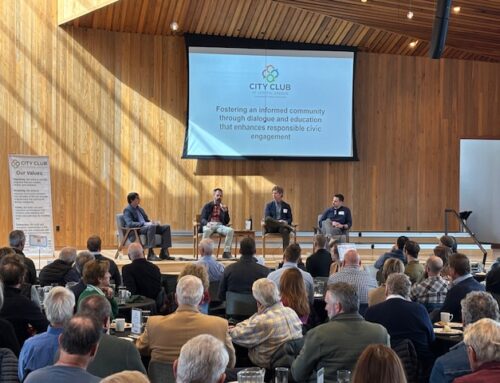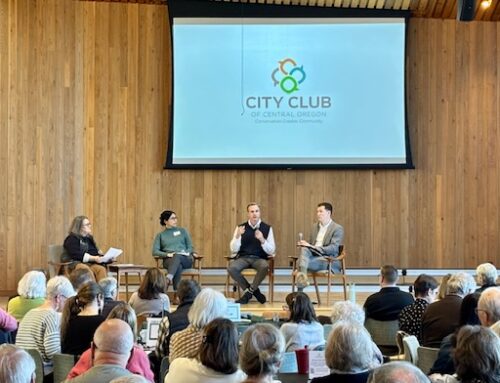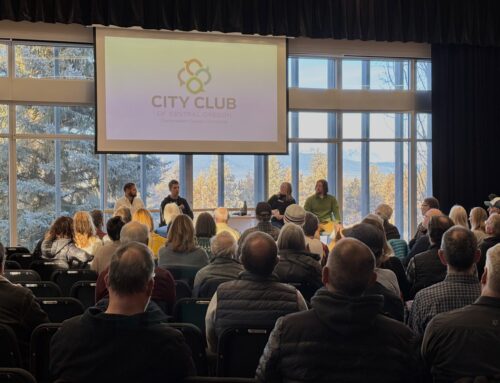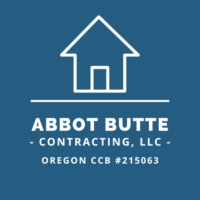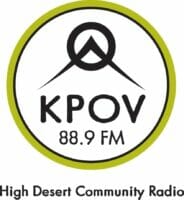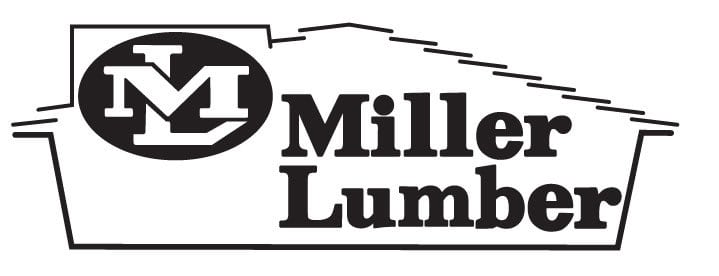Transcript from Forum
[00:00:00] Good Afternoon. City club, friends members, community members. Thank you for being here today. My name is Jacob Fain and I am your city club of central Oregon board president. Also like to take a moment to welcome our virtual audience who is here attending over the internet today. For those of you on the virtual forum, please find information or I’m sorry for those of you here.
Please find information on your table about how to submit questions for our Q and a, and for those online, please look in the chat for more information. Before we get started today, I thought it would be very important for me to just share something that’s on my mind, considering the people who are in this room today.
I know a lot of us, myself included have just been shocked over the past couple of weeks. Starting with Buffalo. Week and a half ago, and then [00:01:00] with the shooting and you Valdi on Tuesday, hugged my son this morning before leaving. And just the sheer thought that this could be the last time that I see him just brought me to tears.
I’ve cried every day for the past few days, watching everything that’s been happening. And there are a lot of debates on what we should do. I don’t know the answer to that, but I do know that there are people in this room who are leaders in our community, who are intelligent, who are thoughtful, who are caring and what’s happening in our community.
It’s more than guns. It’s more than police. It’s more than safety. This is a human problem. And there are opportunities for us to get to know our community members through mentorship, through volunteering, through. Finding ways to make these human connections. And [00:02:00] I think about what we’re doing here at city club, once a month, when we meet engaging in civil conversation and on all of your tables are tools for civility, listen, pay attention, be respectful.
These are all things that we can be doing on a day to day basis. And I just couldn’t come up here today and not talk about these things because I know we’re all thinking about them. I know it’s been weighing heavy on me for the past few days. So I just call on all of us to think about what can we be doing?
What could be doing differently? What could we be doing better, especially to our leaders who are here, who have influence over what’s happening in our community. So thank you for giving me that moment.
So before we get started I’d like to thank all of our community [00:03:00] platinum and gold sponsors and partners, including ASI wealth management, the city of bend central Oregon community college, OSU cascades, the central Oregon association of realtors and Brooks resources. And thank you today to our forum sponsors the energy trust of Oregon new buildings program and pinnacle architecture.
Thank you everybody for supporting civic conversation in our community. As I mentioned on your table, are those tools for some civility, take them with you. We’ve got them out front too. These are just great things that we can think about as we’re going about in our conversations with our friends, with our family members, with our, with our fellow community meals.
And as we go into the question and answers and our conversation today, we encourage you to refer to these tools of civility there as well. How we’re asking the questions, how we’re engaging in questions or conversations that we may disagree with. [00:04:00] So Monterey Monterey moderating our forum today is the special projects reporter for the bulletin, Zack to Mars, no stranger to city club.
He’s done several great forums over the past year and a half or so. If you’ve had a chance, please spend some time to read his piece in the bulletin. It was in this past Sunday about wildfire resiliency in our community, which will be the topic of today’s forum. Zack it’s all yours.
Thank you. Well, thanks so much, Jacob, and welcome folks to this afternoon’s forum. It’s great to be back at city club, particularly as we’re headed into the summer and into our next wildfire season. And I just, I just want to thank Jacob again for his thoughtful words about the events of this week.
I’m really hopeful that if we can come away with anything today, we can come [00:05:00] away with hope that despite the disagreements we may have about many, many things in this country, there are things that each of us can do to make a difference right now and today. So I’m hopeful that we can we can walk away with that today.
Our topic today, as we talked about is wildfire. A wildfire risk is a wildfire season is right on the horizon. This summer. And the growing threat of fire in Oregon is not at all theoretical many central Oregonians. Remember the fires that we’ve seen here in today’s opening slide show, we saw the Opry hall fire, the skeleton fire, both in the 1990s, the 2017 Milly fire near sisters, the 2021 Darlene fire near LA pine, and many, many more.
And furthermore, if we don’t remember those, or if we’re new to the area, no one can forget and no one can drive to Portland without recognizing the terror. That was the labor day fires of 2020 in the Santiam canyon, along the McKenzie river and in Southern Oregon for decades, [00:06:00] our forest floors have filled with combustible fuels until some of our more recent efforts to reintroduce fire to our landscapes.
And. Warming planet has dried out the fuel for fire and increase the likelihood of mega fires in the right weather conditions across the west. But while this picture is grim, there is hope for decades, elected officials, fire departments, state, and local agencies. And most importantly, our community members have made concerted efforts to reduce the risk of harm from future wildfires.
Today, we’re going to hear about some of those efforts, identify resources that we can all take back to our neighborhoods to prepare and discuss the ways our communities can think about fire resilience in a changing climate. So let’s go ahead and begin the conversation. If I can have my panelists come up and join me, we will go ahead and get started.[00:07:00]
We’ve got a great panel of experts joining us here today. First Jodi Barum was previously contracted as the project wildfire program manager for Deschutes county and is now co-coordinating Oregon living with fire, which which covers Deschutes, crook, Jefferson, and the Northern part of Klamath county.
This year, she’ll be finishing up work with the international association of fire chiefs ready, set, go program, and was recently appointed to their wildfire. Policy a wild land fire policy committee. And when the fire pit fire season picks up this summer she’s also deployed as a public information officer on a Northwest incident management team.
Next up Craig Letts is an expert in wildfire, mitigation management and policy [00:08:00] before starting Tamarack wildfire consulting. Craig spent 25 years with the federal government retiring as a fire staff officer for the Deschutes and Ochoco national forests and Prineville. He served 15 of those years with the national park service honing his skills, using wildfire as a tool for ecological restoration in grand canyon and crater lake national parks, and last, but certainly not least bill booze started in the fire service in 1983.
And in 1997, took a firefighter paramedic job with the city of bend fire department. He rose through the ranks and is currently the operations chief for Ben fire and rescue. He also serves as the vice president of the Oregon fire chiefs association is a plan section chief for the Oregon state fire Marshall’s incident management team, a member of the Oregon state fire chief’s wild-land policy committee, legislative committee, ground emergency medical transport committee and international [00:09:00] fire chiefs elections committee.
So welcome to our panel and let’s go ahead and dive right in. Shall we to start No, let’s start very broadly with this question. Where, where does wildfire preparedness and wildfire preparation begin at what point in the fire season should we begin thinking about, are we prepared for fire season? I think it’s all the time.
There are things that people can do year round. There are programs year round, whether you’re in in an elementary school going through the fire busters program in October, or you’re a homeowner getting your property ready and clearing debris. It’s, it seems like it’s a never ending process.
But it does, it starts with the individual and that preparedness is key. I don’t know if you guys think of other seasonal thing. Well, I agree. I think our seasons are getting longer and longer. They start earlier and [00:10:00] they go later. And so dealing with the fuels around your home is a really non-stop process.
And the building materials, we’ll talk about ventilation screening at some point, and, you know, being able to check that and, and guard against rodents and other animals that tear that up and just make sure it’s in shape for fire season is a never ending process. I completely agree. I it’s it’s year round really take advantage of the spring, spring time to be able to get in there and make some big fuels reduction management around your homes, even in the communities that we have.
And. Particularly and you know, we’ve got we’re densifying homes. I’m a lot closer. So just making sure you have the right burning, you know, right materials on your homes and then clearing all that space. So, I mean, it’s, it’s year round, a year round process. And bill, maybe this is a question for you. If we hear or see about a fire headed our direction and we’re waiting for the fire department to [00:11:00] respond and save our homes specifically, are we, are we too late at that?
Well, hopefully if it’s coming near you, you’re evacuated. But yeah, so, I mean, really fire fighting starts at prevention is everything you do on the front end, that’s going to make a difference of what we’re going to be able to do for your home. So, I mean, if you’ve got clear defensible space and that kind of stuff, cause we have limited resources that we can do.
We’re pushing fire around structures and moving onto the next and trying to save as much as we possibly can. So you, you know, here in central Oregon, we’re really lucky because we do work with all of our partners. So that’s us forest service. We’ve got Kevin stock here with the us forest service, Oregon department of forestry.
And we all work really well together. I look at you know, we’re in the, in central Oregon where we’re in a. We’re in an urban setting or a, you know, an urban fire area in a rural setting. And so we have to be a standalone and we have a lot of really good working partners with one another. So[00:12:00] you know, once it gets to those points, usually, you know, if you do have a fire coming in what you’re going to be evacuated way ahead of time, but whatever you can do on the front end is going to make a big difference.
And I think we have a kind of, a lot of misconceptions about how fires actually work and how they spread. Can, can, what do you maybe kind of dive into how fires get into neighborhoods and how they spread from home to home? Because it, the way I understand it, it’s not kind of the wall of fire that we might imagine.
So how does that, how does that work?
I’ll take the first stab at it. Yeah, what, what we’ve learned over the years is that most home ignition start from embers and embers travel well ahead of the main fire. And it can be. Like Ember showers, like rainstorms with the winds in front of a fire. And they’ve been known to travel as far as two miles.
And in some cases, even farther in anywhere they land and find receptive fuel, they start another fire. And if that’s next to your house, then that house starts on [00:13:00] fire. And then it usually leads to a structure to structure ignition and the denser neighborhoods. So that’s what we’re trying to guard against.
It’s really the embers that are really the biggest thing that we’re trying to protect again, and just take away. Most of the flammable stuff from the closest proximity to your house is going to be the best benefit. Yeah. You look at 2020, we really had a unique fire season, right. It was the perfect storm.
We had beachy Creek fire, you know, it was a small fire fed. And the wind’s just set up perfectly for a big event. So he had beachy Creek, you had to holiday fire through Mackenzie open chain down in Southern Oregon, the Alameda fire, which was structured a structure. It wasn’t even a wild land fire.
So it is the ambers. It is, you know, how close you are to the homes. You know, how close homes are, how continuous that is. So if you have, you know, fencing, that’s hitting every home, that’s continuous fuels. And so we’re, you know, we’re seeing that more and more, if you ever get a chance the Miller tree [00:14:00] farm up here on the west end of Ben is a perfect example how to build into the urban interface.
So we really had a lot of different fires in 2020 and the impact. So to, to Craig’s point though, it is the ambers that make the difference. And it’s how your homes are set up to be able to sustain those embers that are there that are landing a mile or two miles out. And, and what are the things in those neighbors?
You know, the specific name of the tree farm that you pointed out, but what are the things that we can kind of do in our neighborhoods, particularly maybe if we’re in denser neighborhoods, how can we interrupt that spread? Or maybe a better place to start? Is can we interrupt that spread once it’s, once it’s in our neighborhoods?
Yeah, I think absolutely you can. And whether you live in a neighborhood like the tree farm, or you live in in the city in higher density housing, or in a mobile home park, there are things you can do to protect yourself from those embers. [00:15:00] And the more that you do for your property in your home, The better off your entire neighborhood will be.
And what we’re seeing is when we can string together, a few of those homes, you really do break up that fuel. So we do have programs in this area. Firewise USA is one. And for those in the room there is literature on your tables as well as over by the ice tea, to give you more ideas of how to break up that what we call that continuity of fuel and to address different home types and how to protect yourself as well as your neighbors.
Because we see once you start increasing the amount of people participating, and we know everybody’s busy, but just that little bit can save your life, can save your property, can save your neighbors. Yeah, I’d add to that, you know, in the, in the denser neighborhoods that even if you have five feet, if you have a five foot side setback on your house, there’s a lot you can do with [00:16:00] that.
So if you have a little ornamental, evergreen tree there. Probably not a great idea, especially if it’s next to your fence that you share with your neighbors. So really think about that. If you, the studies are showing that that first five feet surrounding your house is the most important zone to be managing.
So we want to make sure that there is no flammable material in there. There’s other products out there now, the verdict’s still out on there on whether they work well or not, but there are fire-retardant applications that you can apply to privacy, fencing to wood. There’s intimacy hints that you can apply to your pain to try to increase the fire resistance of your Cedar siding or, or things like that.
So there are other products out there, and if you have the capacity to try to use those tools, I would suggest that you try to use them.
Great. And so, you know, when we talked about this question of density and we touched on. We talked about the tree farm, which is a very kind of spread out neighborhood. There’s lots of space between the homes, [00:17:00] but when we’re building denser neighborhoods in denser communities, do we have a sense of how that impacts the risk to those communities?
I mean, do we know if denser communities are more at risk of that house to house spread or is some of that, you know, kind of research data? Not, not out there yet? Well, the research data is out there. I mean, if we, if we have a structure fire and we have high winds that are behind that, that, that is going to be very difficult for us to potentially stop that from going home to home, depending upon how quickly we can get to that structure fire.
That’s why it’s really important. And I have my chief Todd Riley here also as, you know, response times, we want to keep that down. So we get to those structure fires quickly. It’s, I mean, it really, you know how your home is built, you know, that siding that you have on there, shake room. Those are going to have a huge impact on, you know, what happens with a fire if you look, or if you, I don’t know how many of you were here when the Aubrey hall fire hit, but you [00:18:00] know, that started in Shevlin park.
And one of the things that’s unique about central Oregon is most fires traveled Northwest to Southeast. So if you look at the Opry hall fire and the travel of that, it was a crown fire, which means it’s a fire up in the trees. And then it had a ground fire below it, and it burned up a lot of structures, but that was due to the fact of shake roofs.
That was a big thing back in the day, homeowners associations, they want to just shake roofs. You think about Sunriver black Butte. And that was part of the building. So we’ve come a long way as in, in how we you know, build those homes and, and, and doing the best that we can with, you know, having the right, the right building materials, to be able to prevent that from.
Well let’s turn now to some of the actions the state has taken. 20, 21, the Oregon legislature passed SB 7 62. That was a $220 million bill aimed at preventing and stopping and slowing future future wildfires particularly in light of the 2020 fires. And [00:19:00] so, you know, I guess the question for our panel is what are kind of the key factors.
I know there’s like 12 different agencies that are a part of this bill, so I doubt we’ll get to them all today. But what are the key things that, you know, individuals and individual communities are gonna need to take out of that bill and are going to have to do in response. I think Senate bill 7 62 is ground.
It’s a big change that we have here at California. Actually enacted that years and years ago and we’re way behind the curve on that. And I think the eye-opener was the 2020 fires Senate bill you know, like Zach was saying Senate bill 7 62 has impacted a lot of different agencies. Oregon department of forestry is heavily involved with enacting that.
And there’s still a lot of things that are out there that need to get buttoned up on that. So that OSU right now is doing mapping for the state of Oregon. So every county you’re going to be, it’s going to be mapped, so extreme fire risk and then, you know, higher and lower risks. So we’re going to be seeing that.
I think it’s coming out at the [00:20:00] end of June is really when that is due out. There’s a lot of timeframes or timelines for that. There’s a defensible space code. That’s going to come out of there from the Oregon state fire marshal’s office. So that. Man a mandate, our defensible space hardening of homes.
So the construction of homes, the builders, you know, they’re behind that. The tough part is getting supplies. So supply chain issues and getting all of those products modernization of responses. So how we’ll respond to two wildfires in the state of Oregon community risk reduction. So, you know, fire free Firewise communities.
We, we see that, you know, here we’ve got several of Firewise communities. Firewise actually was, came out of central Oregon. Because of what happened with the Aubrey hall fire. I can’t remember what insurance agency came to the city of bend fire department and said, Hey, we’re going to buy you a firetruck.
And at the time Gary Marshall, who was our fire, Marshall said, Hey, I got a, I got a better idea of what if we go out and we [00:21:00] educate people on how to protect their homes and be in front of this. And so that was started here in central Oregon and is nationwide now. So and, and so I’m, I’m a little off topic and then capacity.
So being able to handle, you know, all of the fires that are out there. So there’s a lot of, there’s a lot of moving parts when it comes to Senate bill 7 62, but it’s a, it’s a, it’s a game changer for us in the state of Oregon. And then counties are going to have say in that communities are going to have say there’s going to be time for community input on, on all of those pieces.
So yeah, there’s a lot of moving parts to it, but it’s it’s gonna, it’s gonna make a big difference. Yeah. And one of the parts from Senate bill 7 62, that I’m most excited about in our work has to do with the youth conservation Corps here in Oregon. So here for central Oregon, we have heart of Oregon core and they’ve helped years on end with fire free days out at not landfill, but through Senate bill 7 62, we’re going to be able to deploy some [00:22:00] of those resources here locally to help property owners clean up their property to create defensible space, to chip some of the debris around homes.
And so we’re really excited to be partnering with the heart of Oregon on that. And I expect to hear more as Senate bill 7 62 gets implemented like bill said, there’s a lot of moving parts to it. And like you mentioned, a lot of agencies involved. So as we know more, as things come out, we’ll want to make sure we let the public know what resources are available to them.
And, and to, to the elements of 7 62 that are going to really impact homeowners you know, the, the mapping requirements or the, the mapping process and the defensible space and building codes that come after that you know, we don’t know what those building codes are yet, but do we have a sense of, to what extent building homes that are fire hardened changes the cost of those [00:23:00] projects?
I mean, do we have a sense that it’s a significant cost or what’s our, what’s our sense of that? The added cost of, of heartening a home against fire? Well, I there’s, there’s not a lot of good data out there for that. There are, there have been some studies that. Range anywhere. I don’t even remember the numbers honestly.
And there’s a lot of people that think those are high and there’s a lot of people that think that they’re, they might be even artificially low. I can tell you from my experience working in the tree farm and west gate and discovery west, and some other places that, that when, when you really talk about hardening your home, you’re talking about ventilation is the most important thing.
And that’s, that’s simply making sure that your foundation vents that come standard with a quarter inch opening wire mesh gets changed out to eighth inch opening wire mesh. And that’s the same for your soffit vents or your open events for your attic. That’s, that’s the most important thing that you can do.
Other [00:24:00] things that we talk about is fire resistant, siting things like Hardy plank that are used very commonly in this area and dual pane windows and or tempered glass go a long way. And, and those are all. Standardly used, you know, so I personally don’t see that there’s a significant increase in cost to fire to make your home more resistant to fire there’s things we can do with our decking materials that we’re going to start looking at in some of these developments as well.
But I don’t think that that’s a big driver of, of cost quite honestly. I’m sure there’s folks that would disagree with me, but that’s what I’ve been seeing out there. Yeah. And one of the things we know from Jack Cohen’s work and since the late nineties into the two thousands, is that if your home is hardened or you’ve created that defensible space, it’s 80% more likely to survive a wildfire.
And so that needs to be factored in as well. Just doing that bit of work or hardening [00:25:00] that first zero to five. Gives you that much more chance of surviving that wildfire. So I would hope that people take that home that tidbit home as something to, you know, it’s hard to put a number on, but if you can save your property and its contents in the case of a wildfire, then that has a lot of value to it as well, in addition to, you know, whatever the costs when you’re rather than starting from scratch, building a home.
Yeah. And I know some of those came along with 7 62 and some already exists in the community, but what kind of supports do we have you know, across the community and across the state for our most vulnerable folks, our most vulnerable communities to get resources, to do some of that work because obviously not everybody is physically able or financially able to you know, clear the space around their home for, for one reason or another.
Supports or resources do exist for, for [00:26:00] folks who need that support. And maybe what more work there is to be done. Well, I mean, that’s, there’s grants. So because of Senate bill 7 62, there is funding mechanisms that are out there. But it’s also helping your neighbors and, and, and helping them. So you may have people like Zach were saying.
They just can’t physically get out there and do those things. And so it’s helping one, another, those, the neighborhood associations coming together. We’ve been out talking to neighborhood associations all spring myself and Nathan Gabby with the Sheriff’s office. He’s an emergency manager for Deschutes county.
And, and, and walking through, you know, all the different things that they can do. So there is funding and to what Jody was talking about is the the core they’re really going to be heavily involved in that. Cause they kind of went hand in hand with 7 62 when we were passing that through the legislature was both of those coming together.
So there, there are things, but it’s one of those things where it takes [00:27:00] a little bit of time to spool that up. We’re you know, to shoot. I don’t want to bang a drum, but we’re ahead of the curve. And a lot of different ways. We have a really progressive forest service that does a lot of prescribed burning.
That’s super important for us to be able to prevent fires from coming in. But there, there’s going to be ways for people to be able to, you know take care of their homes and PR and PR and have their homes ready for, for fires. It’s just the funding mechanism in getting that thing.
And I think we’re also going to keep working to create resources for folks on the ground and doing more outreach. We realized that there is a gap there. There’s sometimes a language barrier that occurs there’s sometimes. Understanding cultural values and really just finding the time and the capacity, because for as much funding, as it seems like is coming, we need to make sure we have the workforce to carry it out as well.
And so wanting to [00:28:00] get people plugged in. And that’s where, you know, you have programs like project wildfire here in Deschutes county. We have Oregon living with fire that I cover, but hearing from those communities and doing direct outreach because we do have blind spots and we recognize that.
And so having certain neighborhoods brought to the attention of someone is a way to get help and resources to those more vulnerable populations that truly need it. Yeah. And, and we talked about, you know, some of the differences between the shoots county. We talked about Deschutes county being a little bit ahead of some other communities.
What, what are some, some examples of that, you know, of successes in our local wildfire, preparedness that in my thinking might be examples for other communities, but might also be examples for the way we think about preparing for other kinds of disasters. What are some really successful examples that we’ve seen here locally?[00:29:00]
The two bulls fire? So two bullets fire was five 16, June of 2014. I got to be the acting mayor for that because the mayor was out of town. That fire was lining up to be Audrey hall all over again. Perfect wins. I think we were all there. And so it was looking like it was heading in that same direction.
And if it really, the big difference was all the fuels management that the forest service had done on the west end of town is what stopped that fire. I mean, we got help from the winds, but that really was a game changer for us because we thought for sure that that thing was going to head right through Skyliner over skyline or, you know, throw.
And we were looking at, you know sunrise village all over again. And so it was all of that being proactive in the fuels treatment that the forest service did. That was a game changer for us because it w we, it was the pucker factor was right there on that fire. [00:30:00] Well, and that’s where, like we talked about and the embers, I mean, embers were flying in that fire and pushing towards those neighborhoods, like Saddleback, like Northwest crossing, the evacuation levels that were happening were threes and twos.
And so people were trying to get out and come into town and evacuating animals and evacuating homes. And it really was, I think one of those success stories of things working well locally. Yeah. Well, one thing journalists loves to love to do is ask people to predict the future when they simply cannot do that.
So that’s what I’m going to do now. Fire season, right around the corner we’ve had a fair amount of rain and a fair amount of snow. So that means. It’s fine. Right? What are we looking forward to? Well, what can we expect this summer? As far as you all can peer into your crystal [00:31:00] balls? Well, yeah, firefighters are kind of picky because if, if, if it’s a low snow year, then they complain about that and they’ll tell you that it’s going to be a bad fire season.
Cause it was a low snowpack. And then when you get a big snow pack and lots of rain in the spring, they say, well, that’s just making more fuel grow out there. So it’s going to be a bad fire season. So. The the takeaway in my years is that there’s going to be a fire season. And it really depends on where the storms line up and, and unfortunately most of the large fires are human caused fires anymore.
So the, I think we’re probably in the 60% of our fires in central Oregon are our human caused fires. So, you know, we need to do a better job about having a presence out in the forest and, and, and having people understand the dangers that exist from fire out there. But I know that as, as bill said, that we’re really fortunate to have the resources that we have in central [00:32:00] Oregon and, and the cooperation and coordination between those resources is pretty unparalleled in my experience.
Yeah. If you look at one of the things early predictors right now, you know, we had the bootleg fire last year, third largest fire in the history of Oregon. And the drought monitor index was circling right down in that area. So Klamath and lake county, now that drought monitor indexes, as we transition through the summers.
It’s coming right through central Oregon. It’s on this side of the cascades to John Day ish. Right. And then up, up into Washington. Right. So, I mean, to Craig’s point, it’s going to look like it’s going to be a pretty bad fire season. And we’re right in the heart of where it could potentially be. So you know, we have a, had a lot of rains which is great.
The grasses are growing. Everything’s great on that end, but it’s dry out east. We were just talking about that when we were having lunch. So, I mean, it’s already [00:33:00] dry out east, you know, we’ve got snow on the mountains. I think elk lake is still frozen. So there is, you know, we’ve got that up in that area, but yeah, everything.
You know, it depends. And like Craig was saying most of the big fires are human caused. And I, and I hate to say that, I mean, lightning strikes have gone down actually in the last few years where we used to the skeleton fire started because of a lightning strike, you know, and we burned through Sundance.
And I think all of our Tatum who’s on our rural district. His home was impacted by that when he was a kid. So you know, it is it is, it is lining up for that. I’ll tell you how it is in October of, you know, really what happened. So but if we do our part, hopefully it won’t happen in, in this neck of the woods, but it’s going to happen.
Yeah, the best fire is the one that doesn’t happen. And so looking ahead that crystal ball, you can think, you know, what’s going to happen based on all the indices. And that’s where being prepared [00:34:00] matters because it could be bad. Like last year I was, we were talking at our table before we came up here.
And last year in middle of June, my incident management team went down to Arizona. Well, we’ve got folks down in New Mexico now a month ahead of that. So is that an indicator that things could be worse this year because we seem to be about a month ahead of schedule. Maybe not, you just don’t know. But that’s where if you’re prepared for the season, you know, some of us will get to stay home more and do our jobs, or we’re going to get deployed and we’re going to serve the communities that we get dispatched to.
So it’s hard, it’s really hard to tell. But that’s why I’m so grateful for this forum. And for our news partners and our other many agencies and communities here in central Oregon that want to talk about this now, before we’re in the heart of the season. Well, on that topic of [00:35:00] preparedness. Great. We will one more question here before you, and then we’ll jump into questions from our audience.
If you have. Obviously, as you can see the information on your table and up on the screen above us, but what is one thing that, that you all would recommend to the folks here watching if they were to take home? One thing that they’re going to do are going to think about when they get home today or when they log off the online stream, what would that one thing be?
Yeah, for me, it’s the zero to five feet, I think, you know, go, go home and, and take a look at the vegetation that you have within five feet of your home. Take a look at if you have you know, shrubs or ornamental grasses right next to the privacy fence that you share with your neighbor and really think about what you might do to, to reduce the flammability within five feet of your home.
I’ll add I’ll pick one. That’s different that if you’re prepared, you’ll be less [00:36:00] scared when wildfire happens. So I would say sign up for text alerts, emergency alerts from your account, the emergency management, and then here in central Oregon, if you text C O fire 2 8, 8, 8, 7, 7, 7, you can get updates even on prescribed fires.
So some of the non-emergency ones as well. So that would be my two. Well, I agree with both of them a hundred percent, I think also be prepared to last two weeks also with the no power the power companies are going to be very aggressive this year in shutting down power. Because that was a lot of the impacts from those fires in 2020, that impacted Detroit and, and the Mackenzie area.
So the power companies are gonna be shutting power off a lot sooner and, and keeping them off for periods of time. So be self-sufficient have at least two weeks worth of stuff and, and and go and especially if you’re in the urban [00:37:00] interface go bags, be prepared to evacuate if you have to.
And that would be my takeaway. Great. All right. Well Let’s go ahead and jump into some questions from our audience here. Again, if you have questions, you’ve got the information above me and on your tables. If we need to evacuate parts of town due to fire, do we know if we would have traffic backups, preventing people from getting to safety?
Where are the cops PD. They are the ones that manage evacuation. So you know, we’ll be involved in fighting the fires, but law enforcement handles that. And it’s a big deal. So, you know, it is it’s organizing traffic. It’s working with the streets department, Oregon department of transportation, moving people from point a to point B.
We’ve had a lot of conversations with neighborhood associations on the west side of bed, you know, while there’s only the bill hilly bridge and there’s[00:38:00] you know, certain access points from, you know, the west side of bend to go to the east side. Are we going to evacuate you that way? We have no idea until we know which direction the fire’s coming.
We could send you up towards bachelor and come down, you know, down through sun river. But it’s a coordinated event. So there’s not like a specific, this is where you’re going to go piece. We’re not sun river. Or black Butte, where there are a closed community and there are certain ways to get from point a to point B.
So it is coordinated event. It will be managed. We can move. You know, I wish Nathan was here. He could, he could talk about that, but they can move track traffic pretty quickly. They know how many people, time of day, everything else of where people are located. Because if it’s during the day and people are working, they’re not going to be in their homes.
Versus if it’s two o’clock in the morning you’re going to have to move all of that. So, yeah, it’s a, it’s a very quick. Situation, but that’s law enforcement deal. I mean, we work with them and we have trigger points of when we’re going to move or evacuated areas. Like, [00:39:00] you know, Jody was talking about the different evacuation levels, but it’s a, it, it takes all, it takes a lot of folks to make that, make that happen well, and it goes back to that individual, knowing two ways out of your neighborhood.
And if it was dark and you couldn’t see, well, if it was congested plan on that have gas as expensive as it is, have gas in your tank. You could be sitting there for a while because as you’re trying to evacuate you, urgency personnel are trying to get in, in a lot of places. So that’s some lessons that we’ve learned from other communities is part of that preparedness, making sure that if you have to go, go early and be ready for that, So here’s an interesting question from our audience.
Are there any studies that have researched, whether all electric homes are more resilient than homes that use natural gas for heating, cooking, et cetera?[00:40:00]
Not that I’m aware of. There you go.
But I do, you know, I mean maybe if we expand beyond studies, do you know of any differences in those types of homes or is that too hard to say here? I don’t know of any differences in those types of homes at all. So, I mean, it comes back to what Craig was talking about and ventilation in your, in your home and those types of things.
But I don’t, I’ve never heard of any differences. And this next question, will there be consultations available for those of us who want an evaluation of our homeschool? Yes, there, there is. So our, our fire prevention division we’ll go out and and evaluate people’s homes and give them on D ideas on how to do, you know, do those things.
I mean, Craig, why don’t you talk about really what’s going on in Aubrey Bude because we’ve got Firewise community in Albury, Glen, and now you’ve been working with dogs. Homeowners or neighborhood association right recently. And you can [00:41:00] talk about all the, that, just the yeoman work that they’ve been doing in Ann Arbor Butte here recently.
Yeah, that’s a great point. So recently I’ve been working with the ABI Butte homeowners association as, as well as the county Forester, ed Keith and boons Zimmerli with project wildfire and w and what we’ve seen is just a really grassroots effort of that HOA to try to take some fire mitigation measures on at, at the HOA level.
It’s a, it’s an old, an older neighborhood, you know, and a lot of the older neighborhoods in bend, the, the, one of the primary things was native landscaping and preserve all the trees that you can preserve. And so we think about that a lot differently now, but to their credit, they’ve developed their own assessment program they’ve signed up, I think probably in their neighborhood of 20 people to do assessments within their own neighborhood.
And so they have that offered up now. Within their own HOA that any homeowner there can request an assessment and these teams will put it on the schedule [00:42:00] and go out and then do the assessment and make recommendations on how that they can put fire mitigations in place to make their homes more resilient to wildfire.
So that’s just a really kind of a grassroots effort. I’m there just to guide them honestly. And most of that has been done on their own with, with help from some experts. Yeah. And with Senate bill seven 60 tool two, and the risk reduction, the Oregon state fire marshal’s office is really heavily going around around the state and providing classes and getting people like Craig’s talking about it.
I mean, able to come in and be able to do those evaluations. So those there, those tools are out there. So it just takes a little bit of work on on people’s part, but you can get educated on, you know, how to, how to set up a good defensible space around your home. And I was just going to add, thanks bill.
The class that the Oregon state fire marshal’s office is putting on in LA pine in two weeks, it’s called assessing structure ignition potential. And it filled up. So [00:43:00] individuals, it doesn’t have to be someone from the fire department that can do the home assessment. Individuals can learn how to do it for their neighborhood.
And if you’re interested in that, you can get more information on the Oregon state fire marshal’s office, or find one of us after this. And we’d be happy to connect you to either the waitlist or the next upcoming class that there’ll be host. And so here here’s a great question from from one of my fellow renters out there.
What requirements, if any, are there for landlords to reduce debris or create defensible defensible space around rentals, and perhaps beyond that what else can renters who lack a certain amount of autonomy over their homes do to reduce their risk? Well, I can say as a renter I’ve talked to my landlord about it, and whether you go through a property management company, if you have a property management company, you can always put in a work request with the reasoning that [00:44:00] you want defensible space around the property.
And or if you have a good relationship with your landlord you can request that certain things be changed to create more defensible space. I have always had, I’ve always had great success in those conversations at getting those Juniper Tam bushes that are right up against the house that were so popular in the seventies and eighties removed or trees limbed up away from the roof.
So that’s something to start that conversation and don’t be afraid to do that. And if maybe even offer to the homeowner or your landlord to get an assessment done for the property, because we found, we do know that there are a couple of insurance companies that really appreciate having those. And if you happen to live in a Firewise USA neighborhood some of them even offer a discount.
So that’s something, you know, an incentive for those homeowners and landlords to leave. [00:45:00] I think that’s a really good example, too, of why this Senate bill 7 62 is so important because it takes some of the choices out of that and really standardizes the approach and where these actions have to be taken.
So that, that is just a really important reason. One of many why that legislation is going to be very important for us. Here’s a forest and fuels question does clear-cutting increase or decrease, or perhaps how does clear cutting impact wildfire risk Craig?
Well, it, that’s a really good question and I ha I mean it really depends on how it’s implemented. A lot of times it leaves a lot of slash on the ground heavier than normal accumulations of slash. So when fire does come through, it burns more intensely I don’t have a tremendous amount of experience with that because clear cutting isn’t done in the forest service anymore, or any of the federal agencies.
And I have not [00:46:00] personally been on fires with private lands involved where we’re clear cutting still happens. So it, it, I guess I’ll just end it with, it just really depends on how it’s done and how the slash is managed. In, in, in that process,
how does Benz and I would say central Oregon’s, how does central Oregon’s chronic growing homeless, homeless population impact fire concerns, and are there specific efforts underway to target, educate and assist folks who are living on shift?
It’s a big concern for us. You look at Juniper Ridge right now, so, you know we have a lot of folks that are up in that area. We’ve been doing some clearing up in that area. It is county and city property that’s in there. The hard part is we just don’t know where people are. You can’t, they, those the way that when they come into there one day you could go through and you don’t see anybody the next day, there could be, you [00:47:00] know, three or four campers in there.
So it is a big concern. We did have the Juniper Ridge fire. Luckily it didn’t get too far into that area, but evacuation, evacuation routes out of there because the road systems aren’t improved at all we we’re, we’re starting to do some. Working with Nathan Gabby and to shoots county is really mapping out the road system in there.
But we also have homeowners that are concerned about having, you know, the houseless people come onto their property. And so they’ll put rocks and they’ll put boulders out that won’t, you know, one day they were there the next day. They’re not. And, and there’s times when we’re out there in the middle of the night our crews are out there quite a bit.
And just getting around in that area, we feel like we could get out one area and it’s a dead end. So it’s, there’s, it’s a big concern for us. And, and how. And how to, you know, manage that. So and, and it’s new for us. If you look, you [00:48:00] know, China hats, another area that, you know, we have a big concern with down in there because we have Woodside ranch, right.
That’s right on the border of China hat. But a life is a life and we want to make sure that we can get everybody out and and everybody’s safe. So it’s, yeah, it’s a tricky part to say, we have an answer for this. We’re just doing our best to try to educate if we can the importance of that. So it is you know, it is a struggle that we’re having.
Well, and I think there’s two tracks. The first is on the prevention side and whether you’re a weekend recreationist or you’re an individual dispersed camping for a couple of weeks at a time there’s the education of camping safety. And fire that way. And then the other side is the evacuation piece.
If wildfire was to occur near an area that has dispersed camping in [00:49:00] it, how do individuals safely get out and evacuate? And that’s where the emergency alerts and knowing ways in and out of where you are comes to. Ahead. And so I think as we work on both of those with individuals, whether it’s through recreation programs tourism outreach, or through social service providers, we’re trying to get that those education materials out to be put into practice because we can talk to people.
And as most of, you know, try to educate individuals, whether, like I said, whether you’re a recreation NIST, or you’re someone who’s unhoused, it’s following up with those small right actions to prevent fire in the first place and then be prepared when wildfire does occur. How, how can we learn from, and give leadership to our indigenous neighbors when it comes to [00:50:00] historical fire maintenance?
Read that again, how, how can we learn from and give leadership to our indigenous neighbors when it comes to historical fire maintenance? Well, my steering committee and in a lot of groups here locally, the Confederated tribes of warm Springs sit on my steering committee. I know they’re also involved in the central Oregon fire chiefs association, as well as I think the fires that I’ve been deployed to where we work with the tribe it’s been incorporated into the tactics used on the ground.
So I think learning from and utilizing those cultural values, understanding, there are areas of special interest that need to [00:51:00] be protected and they are, and then there are also I think relationships to be forged. And that’s where we’re very fortunate here in central Oregon that there is, I think, close partnership with our tribal nation to the, on the Northern side of Jefferson county, for those that aren’t as familiar with the area.
So I, I think here we S we see that collaboration, we see the voices present and contributing to forest collaboratives, contributing to our local agencies and partnering well. Unless I’m missing something great. Nope. I was just going to agree with that. Great, great. Well it looks like we got about time for one more question here.
So what are the differences in the things that people can do if they live in bend or Redmond or in a denser part of our community versus the things that they ought to be thinking about? If they’re [00:52:00] closer to the forest or in the wild land, urban interface, what are the differences in preparedness that that folks ought to be considering based on where they’re located?
Well, I, I honestly don’t think there is much of a difference anymore. We had a fire. In the Wenatchee area in 2015, that was you know, on the, on the perimeter of town or coming towards the perimeter of town. And it’s spotted. I want to say like a mile and a half or two miles and into an industrial park and, and started a pallet fire next to an industrial building.
And then there was several structured losses in an industrial park. So I think that idea that the fires coming from the forest and that’s where we’ve got a two. Be cautious about it. It doesn’t really exist anymore. We have the potential for fire starting in a lot of places in band and sisters and Redmond, even in, even in our downtown cores with the way the fire behavior that we’re seeing in the way the embers are [00:53:00] traveling.
So I think it’s really the same everywhere. It’s, it’s that idea that we need to harden our structures, do what we can to do that. And then really think about the, the vegetation and landscaping that we’re doing around those buildings to protect them because. The fire can come from anywhere. It can come from a park in town.
And there was a recent study by OSU actually that showed that, you know, our paradigm has always been that the fires are coming from the national forest or the BLM or public lands. And, and most of our large fires are not actually coming from public lands anymore is what the study showed. So that’s one study.
There’s, there’s probably a needs for a lot more, but I think it, what resonates with me is just that idea that the, the federal land management agencies have been working really hard for a really long time to, to try to treat the fuels around our urban areas. And they’ve done a really good job with that.
We need more prescribed fire. They’re working really hard at that as well, and that, that does not come without risk.[00:54:00] But we all have a stake in that. So everybody’s got to do their part and that’s at the county level, the city level and at the homeowner level and the HOA levels. So I think that’s where.
Our thinking is starting to change now that we, that we really all have a stake in this and have to kind of pull our weight. Yeah. And I would agree the wild land, urban interface is where the natural environment meets the built. And here in central Oregon, we have both and, and exactly to what you said, whether you live in the middle of town, whether that’s Madras, Prineville, bend, Redmond, sisters upline, we have natural environment all around us.
We have green space all around us. And so I think that regardless of where you live it might be more important if you’re in a higher density housing area to plan your evacuation a little sooner, there might be more people trying to get out when you are. But I think the preparedness is the same.[00:55:00]
Well, I think that’s a wonderful place to leave it and hopefully a, a place of optimism and opportunity for what we can do next. Thank you so much to our panelists for their time and their wonderful insight today. And thank you so much to all of you for joining us. Here’s Kim Gamond executive director of the city club.
So thank you to Zach and Jody and Craig and bill for being here today and being leading us in this important conversation. We had more questions come in today than I have seen in my time here. So I will be working to get some answers on some follow-up and some resources from this panel as well as some other people that might be best to answer.
The ones we didn’t get to. Also thank you to our planning committee for this forum. Including Zack, Christine coffin, Daisy layman, Ruth Williamson, ML, fetus, and Jodi Lawrence. We could not bring you these [00:56:00] forums, especially in a hybrid format without our members and our sponsors. If you are not currently a member or interested in sponsorships, please feel free to get in touch with me to talk to any of our board members that are here or visit Sydney club C o.org coming up on June 14th, which is a Tuesday forum.
We will be partnering with envision bend for a highly interactive forum to discuss how we can shape the future of bends in the area around Benz. So this is going to be a pretty engaging forum as well as a pretty impactful forum to that. The process that envision bend is going through.
Thank you for being here today. Please continue to call cultivate conversation, even though it feels so difficult sometimes with where we’re at. But conversation and dialogue is what helps us build community. Thank you.

